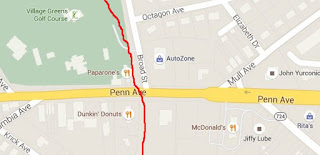By Steve Reinbrecht
The number of new homes built each year in Berks County declined
sharply over the last 10 years.
But there are signs of a reinvigorated housing market in Southwestern
Berks County.
Crews have been turning rich farm fields in Lower
Heidelberg into lots for up-scale housing. And work is expected to start this fall on 60
new houses in South Heidelberg, with hundreds of units eventually,
adjacent to Wernersville.
The home-building industry has not recovered in Berks County
as fast as in the rest of Pennsylvania. The recession that started in 2008
decimated the housing industry in the region and the United States. In Berks
County, only 417 new housing units came to the market in 2015 -- the lowest
number since at least 1980, except for 2011, when only 388 came on the tax
rolls. The highest recent number of new homes in Berks was 2,787 in 2001. Overall,
Berks had nearly 165,000 housing units in 2015, with about 11,000 of them
vacant, according to the Census.
 Last year, Lower Heidelberg had the second-most new houses
in Berks County -- 31 units. It’s one township in Berks where developers are installing
roads and big houses on large lots.
Last year, Lower Heidelberg had the second-most new houses
in Berks County -- 31 units. It’s one township in Berks where developers are installing
roads and big houses on large lots.
Grande Development Co. started developing 49 acres of former farmland in
Lower Heidelberg, around the Wilson School District middle and elementary
schools, in 2013. Plans call for 77 single-family homes, mostly on quarter-acre
lots, and 30 semi-detached homes, along Gaul Road.
Grande is also building 56 houses on one-acre lots on 87
acres, across from the school, that he bought from another developer, Greth
Development Group Inc., for $1.6 million in March, 2014.
 Some might credit the relative quality of the Wilson School
District for keeping the area in the forefront of new housing. The Oley Valley
School District saw 79 new houses in 2015, by far the most that year. But Wilson
School District had the next highest number of new homes – 45. Conrad Weiser
School District had 33 new homes.
Some might credit the relative quality of the Wilson School
District for keeping the area in the forefront of new housing. The Oley Valley
School District saw 79 new houses in 2015, by far the most that year. But Wilson
School District had the next highest number of new homes – 45. Conrad Weiser
School District had 33 new homes.
In South Heidelberg, supervisors gave final approval in
September to the South Mountain Commons development, nearly 190 acres generally
bounded by Furnace, Preston, and Galen Hill roads and Glen Till Avenue.
The builder, LLH LP, of Wyomissing, bought the property from
VIST Bank for $1.4 million in May 2015 and plans to build single homes,
townhouses and apartments. The land is zoned agricultural but will get a
mixed-use overlay, and the homes will use public water and sewer.
 |
| South Mountain Commons |
Crews are expected to start work on the first phase,
comprised of 60 single-family houses, in the fall. They’ll be around a loop
road on a 37.5-acre plot off Columbus Street. An extension of Glen Till Avenue
will be another entrance.
The final plans show 132 townhouse units on 27 acres off
Galen Hill Road and 240 apartments on 10 acres.
In 2006, three Southwestern Berks municipalities were in the
top 11 home-building municipalities of Berks County’s 67 municipalities: South
Heidelberg was 8th with 77, Lower Heidelberg was ninth with 70, and Sinking
Spring was 11th with 39.
The United States had a big uptick in housing starts in
June. Demand for homes has been growing in recent years, with
sales of new and existing homes rising fairly steadily since 2011, with a low number
of new and existing homes on the market.
“The conditions underpinning demand are still in place,
namely historically low interest rates and steady—if slowly moderating—job
creation,” according to the Wall Street Journal. “Tuesday’s report showed an estimated 1.015 million homes under
construction in June, the highest level since February 2008.”
 From 2006-2015, three southwestern municipalities – South
Heidelberg, Lower Heidelberg, and Sinking Spring -- were among the 20 Berks
municipalities with the most new housing units. They had 713 units out of
Berks’ 8,443 total during that time.
From 2006-2015, three southwestern municipalities – South
Heidelberg, Lower Heidelberg, and Sinking Spring -- were among the 20 Berks
municipalities with the most new housing units. They had 713 units out of
Berks’ 8,443 total during that time.
Southwestern Berk’s comprehensive plan identified no housing problems in the region. The planned growth of housing, including much around
Wilson West Middle School, matches the expected growth in the number of new
people, planners surmise.
In general, new housing is an important economic measure. Construction employs a lot of people, and buyers need to
fill their new homes with furniture, flooring and all sorts of stuff they buy
in local stores. Transactions provide the crumbs the real estate and finance
people depend on. New construction also boosts tax revenue.
But many people oppose new housing. The property taxes
raised don’t pay for the demand for new services, such as police presence and
seats in classrooms. Many residents rue the loss of farmland and the vistas it
comprises, and accuse developers of environmental damage and causing too much
traffic on winding country roads.
“Lancaster County has long suffered from a lack of
affordable housing,” the Morning Call
said.
The article predicted Lancaster would gain more than 122,000
new residents by 2040, with Baby Boomers downsizing and Millennials putting off
buying traditional single-family homes in the suburbs.
“The supply just isn't keeping up. Single-family homes still
account for up to 80 percent of the housing being built in Lancaster County.”























